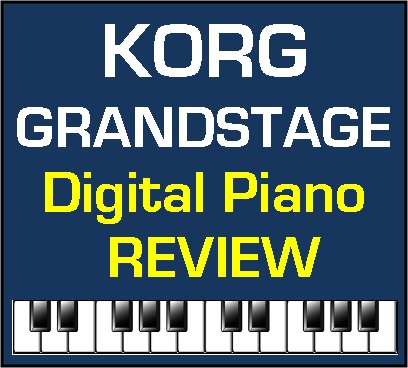02 Jan Korg Grandstage – REVIEW – Stage Digital Piano
By: Professor Tim

Korg Grandstage Digital Piano – REVIEW
Korg Grandstage Portable stage digital piano – REVIEW | for 2022 | $2199 internet price for the 88-key version | $1999 internet price for the smaller 73-version | Lower prices here than Amazon or Internet – The Korg Grandstage is now discontinued and there is no replacement at this time. The Grandstage is a unique digital piano and n our opinion what sets this piano apart from from many other portable digital piano in this price range is the way it sounds and the way it plays…it really is at a “pro level” of realism in our opinion
The Grandstage is an all-in-one grand piano/ full orchestra/synth/electric piano/jazz, pop, and cathedral pipe organ/guitar with many variations, and so much more. The Grandstage is so easy to use and the sounds are so instantly expressive and impressive that you almost cannot believe it. The Korg proprietary piano-weighted key action (which is used in other Korg models) responds well and the combination of the key action and its response to those many instruments offers an incredible amount of dynamic tonal range and control.
Add to that the authenticity of the damper-sustain pedal and the ambient and natural harmonics and sympathetic string vibrations produced from the grand piano tones, and you have an instrument that’s difficult to put down and stop playing. There’s also plenty of polyphony power to play any of the super authentic sounds without any note dropout including when layering sounds together and using sustain all all keys.

Korg Grandstage Control panel
With over 500 impressive instruments and tones including some of the best strings, pads, vintage electric pianos, and organ sounds I have ever heard along with Steinway, Yamaha, Bosendorfer, Fazioli, and Bechstein grand pianos, this Grandstage has really got it all. It’s not for everyone though because it’s not a “workstation” in the sense that you can do any on-board recording and sound creation. It also does not have any built-in speakers nor can it be put into a furniture type cabinet.
The model is for people who are satisfied for having an instrument that they can put on a sturdy metal stand and plug it in to external stereo monitors (or a sound system) to hear the sound. There are 500 incredible sounds in two sound bank libraries which means that each of those 2 sound libraries have the same impressive identical sounds. You can choose any 1 sound in the first library and any 1 sound in the 2nd library and mix (layer) them together or split them with one sound on the hand hand and 1 sound on the left hand and you can determine the split point. You can also easily and quickly set the relative volume between the 2 sounds to balance them out correctly.

Korg Grandstage control panel sound library
In order to select a sound in the “ensemble section” you would dial in a sound category with a knob until you got to the category you desire. Turning the knob lights up an indicator in a red color that shows you what section you have selected. From that point you would turn the ‘variation knob” to get to the specific sound in that category you are looking for. Then you can set your volume level for that sound using the “level knob” and then you’re done. You can leave that sound in the display screen and turn the red lighted ensemble button on or off to hear or mute the sound whenever you want to. Also if you like, you can edit that sound you have chosen by pressing the editing button which will then allow you to customize that sound in some unique and different ways.

Korg Control Panel Favorites section
Since there are so many great sounds and possible combinations of sounds in the Grandstage, Korg offers a “Favorites” section on the control panel which allows for 64 of your favorite sounds or combinations of sounds to be saved and then instantly recalled by pressing the 2 buttons that will get you back to the memory slot where you saved the sound. The top row of buttons goes from A-G and bottom row of buttons goes from 1-8. So you simply press one button on the top row with one button on the bottom row at the same time and then then are able to save your set-up in that digital memory slot such as A1 or C4, or F5, and so on.
To activate the saving procedure you just press the top “write” button just to the left of the favorites section where the 3 buttons are in a row. Then you do the saving procedure, turn the “write” button off and you’re done. Super easy and you can also overwrite that memory slot at any time to make changes or put another set-up in there. There are a total of 64 memories, so if you run out of memory slots and have use all 64 of them, then you can save those set-ups to a USB flashdrive for storage so you do not lose them and use the internal memories for new settings if you wish.

Korg Grandstage light up control panel

Korg logo on back of Grandstage
The Grandstage buttons and other features light up real well in a dark room and it’s nice to be able to identify many of the functions that way. Another fun thing Korg did was to include their logo on the back of the piano that also lights up…only you can control the colors of the logo and select from white, gold, red, blue, green and other color selections. The Grandstage not only can be used in a home studio, in a recording studio, in a church, school, or restaurant, but it can be used professionally on stage at big concerts as well.
The 73-key version Grandstage can be useful because it is identical to the regular 88-key version in every way except for few keys and a lighter weight body. For a piano player who is focused more on piano playing, having a 73-key version may not be very practical because you may not enjoy running out of notes when playing fuller and/or more complex pieces of piano music. But for someone who travels and plays professionally doing music that requires playing mostly chords or you are accompanying a band and/or mainly need to add music here and there “to the mix” with fill-in playing from brass, guitar, string, pad, organ, synth, and other non-piano sounds (and also acoustic piano sounds), then a 73-key version might be the better solution for those situations.

Korg Grandstage 73-key and 88-key digital piano models
Whichever Korg Grandstage you choose, you’re going to get a very attractive looking instrument which has all the functions that most be want and need. It has a very enjoyable piano key-action, pedaling response, and great functionality which will enable you to sound amazing whether you are playing for yourself or for others…and isn’t that what it’s all about…to sound amazing and being able to use the piano functions quickly and intuitively so that you can take advantage of what the instrument has to offer?
That’s why I play piano and instruments like the Korg Grandstage, because I want the music to “move me” and to make me feel good so I can express myself emotionally in the music and really become one with the instrument, and that’s how I feel about the Korg Grandstage. Of course there are always a few shortcomings when it comes to digital pianos no matter what brand and model they may be because nothing out there is perfect, and this is true of the Grandstage as well.
However, the Grandstage also does many other very cool things which I have not talked about here but have talked about elsewhere in a more detailed review I have done of this instrument.

Lower price than Amazon or Internet


